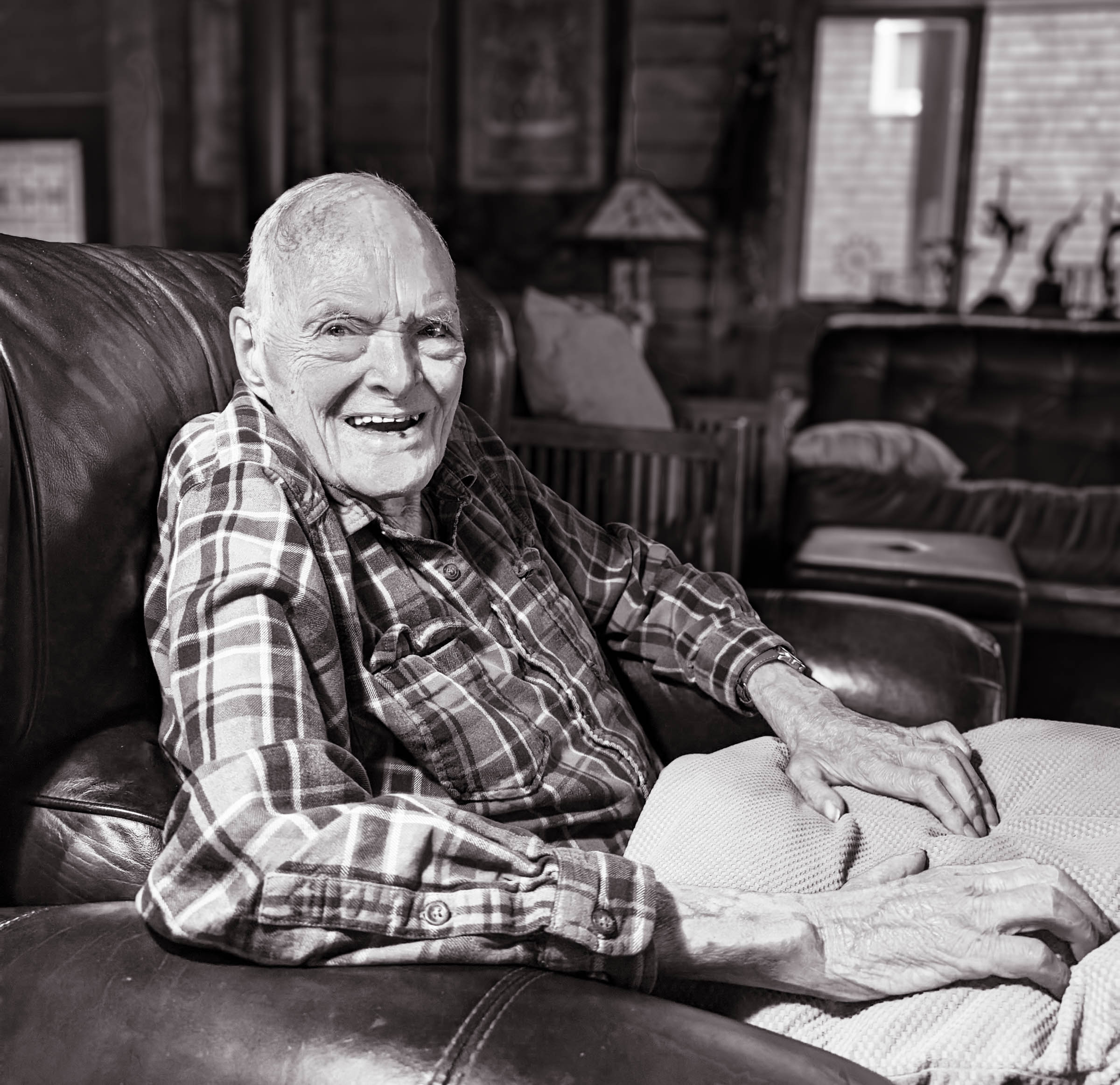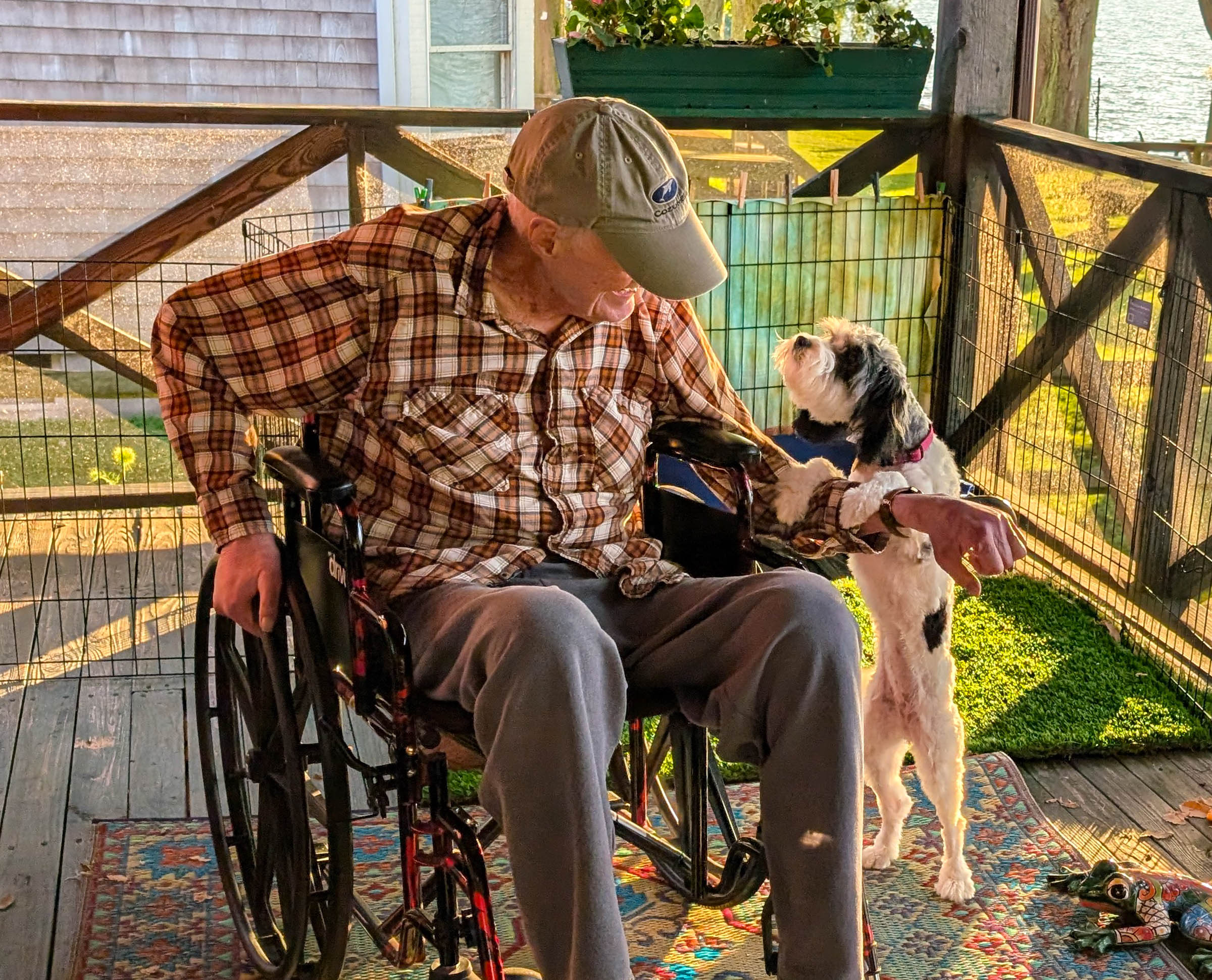 Mad in Pursuit Notebook
Mad in Pursuit Notebook
Death of a Sweet Old Husband
A diary of the final few precious days of James G. Zimmer (1932-2024)
Published in "Crow's Feet: Life as We Age," 11 Dec. 2024
If I want to write again, I can't ignore the most important event of the year--the loss of my Jim. So yesterday, I grabbed a box of tissues, sat in my chair, and wrote this essay for "Crow's Feet." I forgot about "carrying on" for a day and let myself be sad. The story describes Jim's last month alive, so don't read it if you are triggered by death and dying.
Monday, June 17, 2024 — I moved up Jim’s routine podiatry visit to Thursday. He had pointed out a small sore between the third and fourth toes of his left foot.
Thursday, June 20 — Jim’s two toes were now inflamed and painful. Walking hurt. We used the wheelchair to visit the podiatrist. It was comical bumping over high thresholds, dealing with automatic doors that didn’t open, and using a stall in the ladies’ room when Jim had to pee. But strangers were kind and helpful. The podiatrist prescribed an antibiotic and a routine of soaks and careful drying.
Friday, June 21 — I got Jim to his dental hygienist without incident. We were getting used to the wheelchair.
On that beautiful summer night, with Jim in his wheelchair, we took our 8-month-old puppy for a walk.
Later, when Jim used his walker to head for the bedroom, he fell. We had a hell of a time getting him back on his feet. Without both shoes, his sense of balance was shot. I brought the wheelchair inside so he could use it while his foot healed.
I gave him a Seroquel to help him sleep.
Jim, now 92, had been suffering from noticeable cognitive decline since 2010, when he was 78. Slowly, slowly, dementia took hold. We carried on, making adjustments as needed. I became his prosthetic memory. He loved that. I often sensed that he was content to leave all the thinking behind: his medical training, the demands of academia, his obsessive chasing of collectibles. Consistent with his love of Buddhism and the sobriety he found at age 70, he let go of it all. He didn’t become the wise old storyteller. He became the peaceful Buddha instead.
Only recently, he had suffered a couple of bouts of “sundowning,” an anxious irrationality at bedtime. His doctor had prescribed the antipsychotic Seroquel to help him settle down and sleep.
Tuesday, June 25 — Back to the podiatrist. The sore wasn’t worse, but Jim’s two toes were dark, bruised-looking. His foot was cold. It was not an infection — this was a vascular thing. The doctor made an immediate referral to the vascular clinic downstairs from his office.
Within the hour, we were sitting with a woman who said there was an arterial blockage in Jim’s thigh. His foot was ischemic. He needed an angiogram to see what came next. A nurse gave me a new regime for his foot care.
Wednesday, June 26 — I was a wreck waiting to get the angiogram appointment. I rearranged the furniture so that Jim could again use the giant power recliner we got after his emergency back surgery in 2021.
His spirits were good as we endured the days before the angiogram. His foot pain was mild, alleviated with ibuprofen or Tylenol. It was a lonely few days for me. Life shrunk to a small circle with Jim at the center.
Tuesday, July 2 — Angiogram day. Jim’s two toes had turned black. I was anxious for the fix. But word came back from the surgeon. The angiogram didn’t find a path to restore circulation to his toes. They gave me an appointment in a week to “discuss options.”
I was distraught over the long holiday weekend. Another toe was turning black. But Jim continued happily along, day-sleeping less than usual, enjoying our wheelchair walks and movies.
Tuesday, July 9 — The vascular team presented three choices. Brazen: perform an arterial bypass, with no guarantee that it would work or that the improved circulation would last. Definitive: amputate his left leg above the knee. Conservative: wait and see.
Jim was attentive to these choices, but looked to me for answers. I had walked in pumped up to do whatever heroic thing was needed to keep him going. I walked out realizing there would be no heroics. Only care. Only compassion.
Wednesday, July 10 — Panic set in as I realized that “doing nothing” meant that death would proceed by agonizing inches up his leg and into Jim’s bloodstream.
I called his doctor. I said I had no idea what to do. Jim would need more help than I could give, but I wanted him home. The doctor said he’d make a referral to home hospice.
I didn’t know much about hospice. I learned that it was available to people who were expected to die within six months. Jim had outrun death so many times in his long life that I didn’t believe it could come within six short months. Even without a memory, he was still full of curiosity, still engaged, still able to crack a joke, still able to tell me how much he loved me. But the wraparound services offered by hospice sounded good.
Thursday, July 11 — This was a good day. Jim was cheerful. We had mastered the choreography of wheelchair transfers to chair, to toilet, to car, to bed. It made us smile when we got it perfect. I had my kit for the daily betadine foot cleanse, with a supply of loose white cotton socks. A mini-ramp arrived from Amazon that helped me wheel him into the house without having to pop him perilously over the threshold.
His doctor prescribed oxycodone and a stronger dose of Seroquel, anticipating pain ahead. That evening, Jim, the puppy, and I piled into the car to pick it up at Walgreens. Then we spent time on the porch, enjoying the weather and taking pictures.

Afterward, I said to Jim that his foot problem could be the end of him. He scoffed.
Friday, July 12 — Overnight was tough. For the first time, Jim shouted in pain. I gave him the oxycodone with a Seroquel.
The hospice nurse came by around 9 a.m. to do Jim’s intake. He was asleep and barely responsive when she examined him. I assumed it was the drugs. His only words were, “I’m dying.” The nurse gave me a look.
She recommended a full array of services for us, including aides for two or three hours a day.
I managed to rouse Jim enough to get him dressed. We moved from bed to wheelchair to recliner, where he collapsed back into a fitful sleep.
For months, intermittently, he had moaned and groaned while sleeping — a phenomenon called catathrenia. In his chair now, the vocalizations were non-stop. Not pain, I thought, but unrest. It disturbed me.
The afternoon was filled with hospice organizing. Aide appointments were set up. A bag of drugs was delivered, to be used for a variety of palliative purposes. I read up on everything I was supposed to do.
Jim’s catathrenia continued. At 8 p.m. I called the hospice hotline. “What should I do?” I asked.
“Nothing,” the nurse said. “Let him sleep. Keep him comfortable.”
I covered him with a small quilt I’d made years ago from his worn-out shirts. I gave him his pillow to hug, the one with the pillowcase I’d ice-dyed with swirls of blue and green. Then I stretched out on the couch next to him, with the puppy snuggled against me, and tried to sleep.
Saturday, July 13 — I took a quick shower, wondering how long Jim’s groaning “trance” would last and if I had what it took to see this ordeal through.
Later, I pulled a chair close to him and took his hand. It sounded like he was choking. “Squeeze my hand if you want me to sit you up more,” I said. He squeezed my hand. I powered the chair forward a bit. While I sat there holding on to him, I paged through a booklet from the hospice nurse. It described the physical process of dying — the breathing, the throat noises. I think it was only then that I realized Jim might actually be dying.
At 10:55 a.m., his breathing stopped.
There we were. Just the two of us, on a sunny morning in July, greeting death.
And yet, it was still hard for me to believe. His eyes would flutter open any second now, wouldn’t they?
I sat with this ambiguity till 11:30 when the hospice nurse arrived. She pronounced him, then called the coroner, his doctor, and the funeral home specified on the hospice papers.
It was real.
Amid the crushing sadness was also a growing sense of… what? It felt oddly like triumph. His long decline had been an Everest-sized mountain adventure — two buddies in search of the sublime, growing closer and closer as the climb grew steeper, relying on each other, me with my relative youth, him with his undying affection and easygoing fearlessness. The last month was when we reached that scary part of the mountain where we needed oxygen — the final summit. The peak was his destination.
I returned home. Alone. Exhausted. Accomplished.
Books from Mad in Pursuit and Susan Barrett Price: KITTY'S PEOPLE: the Irish Family Saga about the Rise of a Generous Woman (2022)| HEADLONG: Over the Edge in Pakistan and China (2018) | THE SUDDEN SILENCE: A Tale of Suspense and Found Treasure (2015) | TRIBE OF THE BREAKAWAY BEADS: Book of Exits and Fresh Starts (2011) | PASSION AND PERIL ON THE SILK ROAD: A Thriller in Pakistan and China (2008). Available at Amazon.